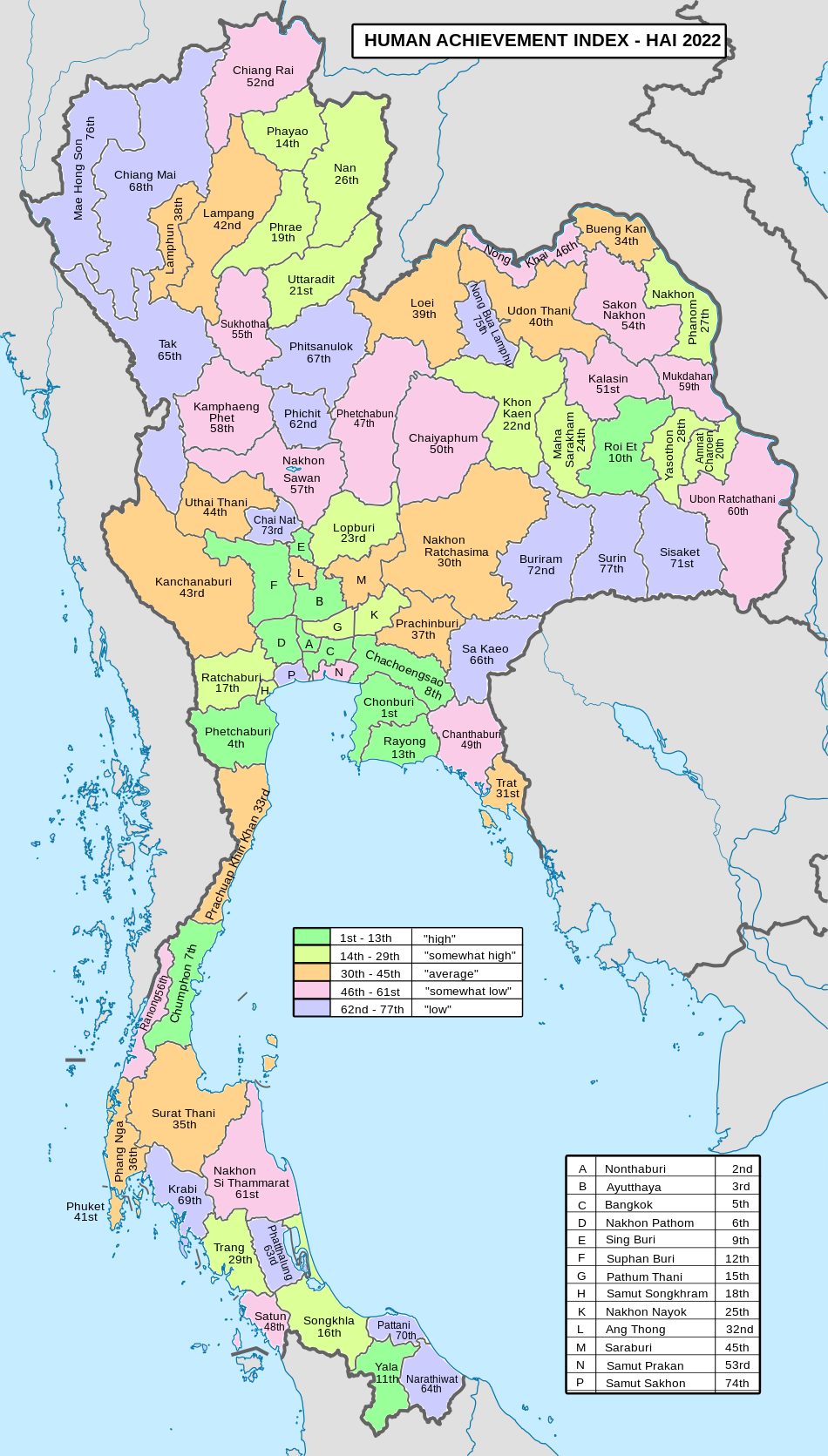Uthai Thani province
Province of Thailand From Wikipedia, the free encyclopedia
Uthai Thani (Thai: อุทัยธานี, pronounced [ʔù.tʰāj tʰāː.nīː]), one of Thailand's seventy-six provinces (changwat) lies in lower northern Thailand. Neighbouring provinces are (from north clockwise) Nakhon Sawan, Chai Nat, Suphan Buri, Kanchanaburi and Tak. It lies somewhat off the route between Bangkok, 200 km distant and Chiang Mai.[5]
This article needs additional citations for verification. (January 2009) |
Uthai Thani
อุทัยธานี | |
|---|---|
 | |
| Nickname: Uthai | |
| Motto(s): อุทัยธานี เมืองพระชนกจักรี ปลาแรดรสดี ประเพณีเทโว ส้มโอบ้านน้ำตก มรดกโลกห้วยขาแข้ง แหล่งต้นน้ำสะแกกรัง ตลาดนัดดังโคกระบือ ("Uthai Thani. City of the father of Chakri (dynasty). Tasty giant gourami fish. (Tak Bat) Devo festival. Ban Namtok's pomelos. Huai Kha Khaeng world heritage. Source of the Sakae Krang river. Famous cattle market.") | |
 Map of Thailand highlighting Uthai Thani province | |
| Country | Thailand |
| Capital | Uthai Thani |
| Government | |
| • Governor | Teerapat Katchamat |
| • PAO President | Phadet Nuipree |
| Area | |
• Total | 6,647 km2 (2,566 sq mi) |
| • Rank | 30th |
| Population (2024)[2] | |
• Total | 320,445 |
| • Rank | 68th |
| • Density | 48/km2 (120/sq mi) |
| • Rank | 73rd |
| Human Achievement Index | |
| • HAI (2022) | 0.6369 "average" Ranked 44th |
| GDP | |
| • Total | baht 29 billion (US$1.0 billion) (2019) |
| Time zone | UTC+7 (ICT) |
| Postal code | 61xxx |
| Calling code | 056 |
| ISO 3166 code | TH-61 |
| Website | uthaithani |
Geography
The province stretches from the upper plains of the Chao Phraya River valley, to forested mountains in the west. The Sakae Krang River, a tributary of the Chao Phraya River, is the main watercourse of in the province.
The total forest area is 3,419 km2 (1,320 sq mi) or 51.4 percent of provincial area.[1]
The Huai Kha Khaeng wildlife sanctuary, at the western boundary bordering Tak province, was declared a World Heritage Site in 1991. It is home to most of the forest animals of Southeast Asia, including tigers and elephants.
Huai Kha Kaeng wildlife sanctuary, along with one other wildlife sanctuary, make up region 12 (Nakhon Sawan) of Thailand's protected areas.
- Huai Kha Khaeng Wildlife Sanctuary, 2,780 km2 (1,070 sq mi)[6]: 25
History
Originally Mon and Lawa settled in the area. The first Thai settlement in the area was Muang U Thai during the Sukhothai Kingdom, but it was later abandoned when the river changed course. The Patabeut people, of Karen ethnicity, revived the settlement at its current site during the Ayutthaya Kingdom. It served as a fort protecting the boundary of the kingdom.
Uthai Thani is the hometown of the father of King Rama I. He later changed the city's old name Uthai to Uthai Thani.
In 1892, King Chulalongkorn (Rama V) added the area of Uthai Thani to the Monthon Nakhon Sawan and in 1898 formed the province.
Symbols
The provincial seal depicts the pavilion at Wat Khao Sakae Krang. It houses the statue of Thongdee, the father of King Rama I and a Buddha footprint. The mountain in the background symbolizes the location of the pavilion on top of Khao Sakae Krang.[7]
The provincial flower is the yellow cotton tree (Cochlospermum regium). The provincial tree is the neem (Azadirachta indica v. siamensis). Giant gourami (Osphronemus goramy) is the provincial aquatic animal.
The flag of Uthai Thani depicts the provincial seal of Uthai Thani in the middle. The yellow colour at the top of the flag is the colour of the Chakri dynasty, symbolizing gold. The green colour at the bottom is the colour of King Rama I as he was born on a Wednesday, which is associated with green in the Thai calendar. The text below the seal says Uthai Thani province.
Administrative divisions
Provincial government

The province is divided into eight districts (amphoes). These are further divided into 70 subdistricts (tambons) and 642 villages (mubans).
Local government
As of 26 November 2019 there are:[8] one Uthai Thani Provincial Administration Organisation (ongkan borihan suan changwat) and 14 municipal (thesaban) areas in the province. Uthai Thani has town (thesaban mueang) status. There are a further 13 subdistrict municipalities (thesaban tambon). The non-municipal areas are administered by 49 Subdistrict Administrative Organisations (SAO) (ongkan borihan suan tambon).
Human achievement index 2022
In 2003, United Nations Development Programme (UNDP) in Thailand began tracking progress on human development at the sub-national level using the Human achievement index (HAI), a composite index covering all the eight key areas of human development. National Economic and Social Development Council (NESDB) has taken over this task since 2017.[3]
| Rank | Classification |
| 1 - 13 | "high" |
| 14 - 29 | "somewhat high" |
| 30 - 45 | "average" |
| 46 - 61 | "somewhat low" |
| 62 - 77 | "low" |
| Map with provinces and HAI 2022 rankings |
 |
References
External links
Wikiwand - on
Seamless Wikipedia browsing. On steroids.





